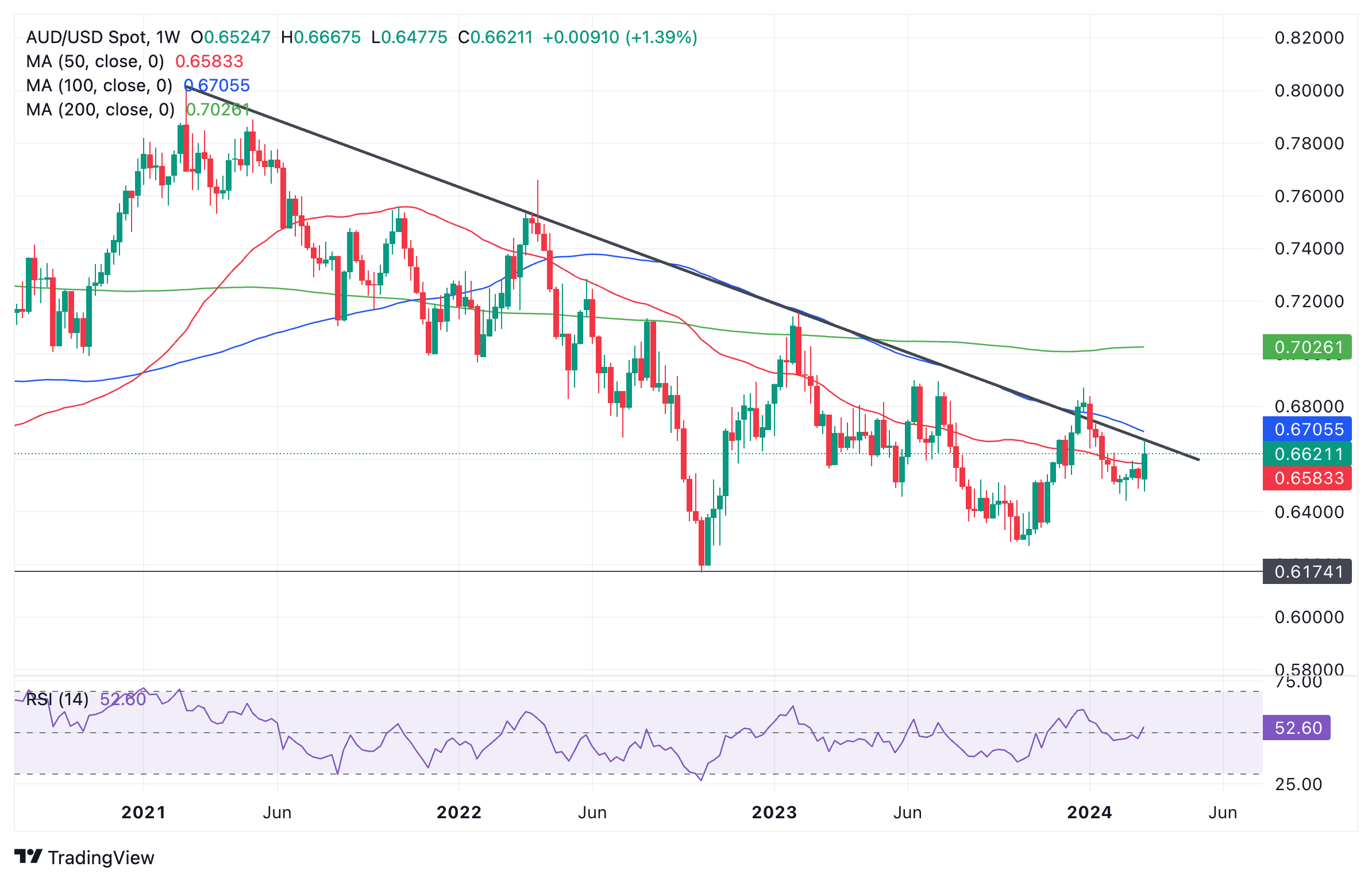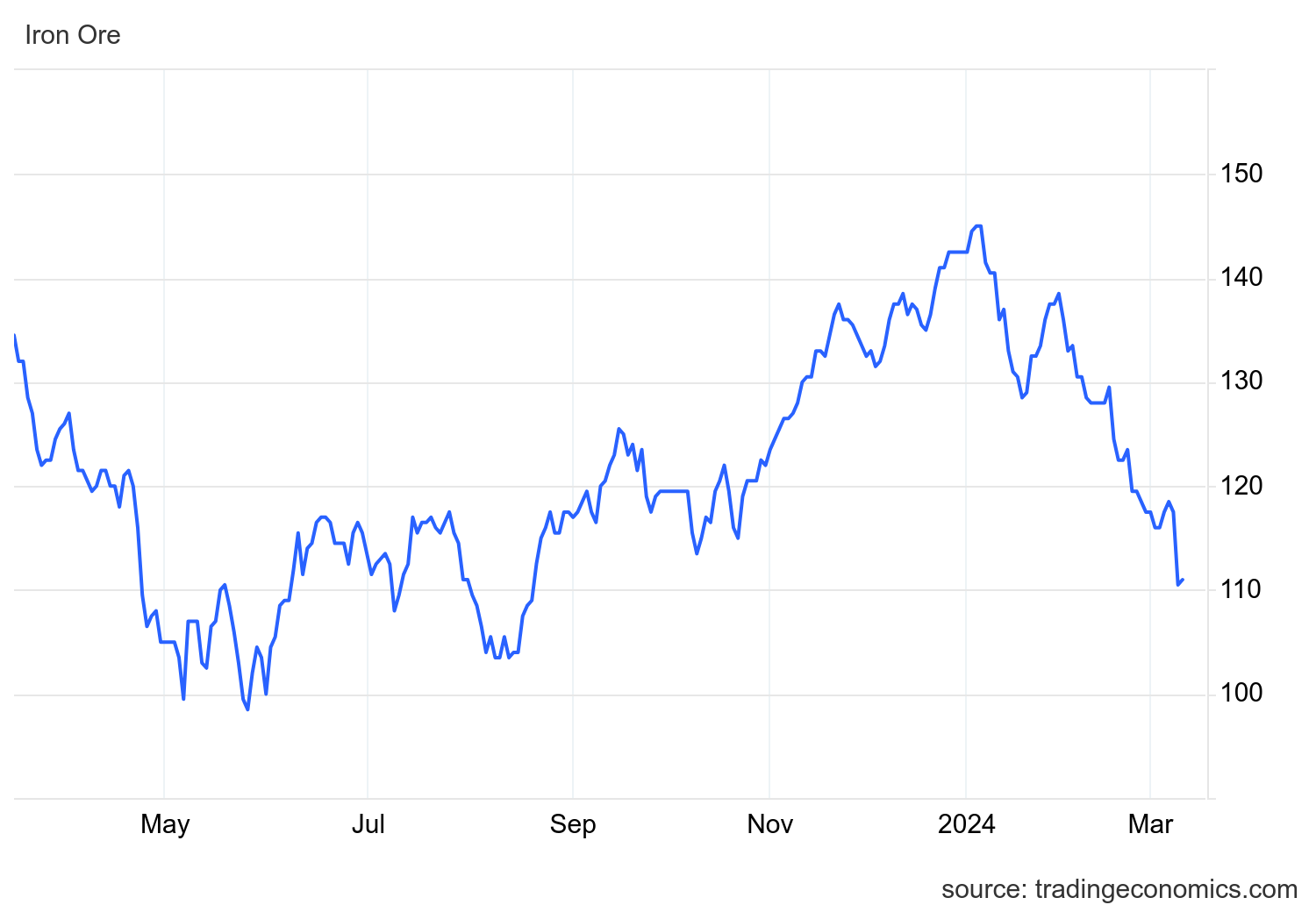- Analytics
- News and Tools
- Market News
- AUD/USD rises on RBA’s relatively hawkish stance
AUD/USD rises on RBA’s relatively hawkish stance
- AUD/USD rises as markets continue to expect the Fed to cut rates in June.
- The RBA by contrast is striking a more hawkish tone, suggesting rates may even need to rise.
- Iron Ore prices are a drag on AUD/USD as they tumble amidst China property slump.
AUD/USD is trading in the lower 0.6600s on Wednesday during the US session. It is marginally up by two tenths of a percent on the day as markets continue to expect the Federal Reserve (Fed) to cut interest rates in June, despite stickier inflation data. Lower interest rates are negative for USD since they mean less foreign capital inflows. This contrasts with the Reserve Bank of Australia (RBA) which may still hike.
From a technical perspective AUD/USD has stalled after rallying up and hitting key resistance from a long-term trendline. Overall the outlook remains bearish as the pair is in a long-term downtrend, producing lower highs and lower lows.

Australian Dollar vs. US Dollar: Weekly chart
Despite recent gains, the mood music around the Australian Dollar remains negative due mainly to the steep fall in price of Australia’s largest export commodity, Iron Ore, which has dropped by over 20% since the start of 2024.

Iron Ore Prices in USD
The decline has been driven by a fall in demand from its biggest export partner China, which is using less iron to make steel for its beleaguered property sector.
Usually the Chinese government comes to the rescue when the economy takes a turn for the worse – not this time. At a meeting of the Chinese National People’s Congress on Monday, the party decided to withhold a bailout for the indebted property industry.
Instead, China’s Communist Party seemed more interested in punishing the property magnates behind the $7.5 trillion market’s collapse, according to news.com.au.
“Those who commit acts that harm the interests of the masses will be resolutely investigated and punished in accordance with the law. They will be made to pay the due price,” said Minister of Housing and Urban-Rural Development Ni Hong at the weekend.
This does not bode well for Iron Ore prices going forward or for the Australian Dollar.
Reserve Bank of Australia split on interest rates
Unlike the Federal Reserve, which is steadily reaching a consensus on the need for a June interest rate cut, the Reserve Bank of Australia (RBA) continues hinting it may have to raise rates even higher than their current 4.35% level.
Inflation in Australia fell more than expected – from 5.4% to 4.1% in Q4 of 2023, but it remains well above the RBA’s target range of 2%-3%. RBA Governor Michelle Bullock stated recently that inflation in Australia is mostly “homegrown” and “demand driven”, due to the strength of the labor market and rising wage inflation. This suggests it is more entrenched than in other countries, and will take longer to fall back to target. Indeed, the RBA does not see this happening till 2026 and Bullock hinted the RBA might still need to raise interest rates to tackle inflation.
On Wednesday, ex RBA Governor Philip Lowe said there is a two way risk on interest rates, and that the current RBA Governor Michelle Bullock was right to issue a warning that interest rates might still need to go higher.
The contrast in central bank policy stances suggests the US Dollar may actually weaken versus the Aussie, neutralizing some of the risks to the currency from the fall in demand for Australian Iron Ore.
Downtrend to continue?
The AUD/USD has just pushed back after touching a major trendline and there is a risk it could fall further, in line with the long-term downtrend.
A break below the last swing low of October 2023 at 0.6442 would solidify the bearish outlook and probably see prices ease further to around the 0.6170 October 2022 lows.
Alternatively, a break above the 0.6871 December 2023 high would indicate the long-term trend was probably reversing and the Australian Dollar might be set for sunnier slopes.
© 2000-2024. All rights reserved.
This site is managed by Teletrade D.J. LLC 2351 LLC 2022 (Euro House, Richmond Hill Road, Kingstown, VC0100, St. Vincent and the Grenadines).
The information on this website is for informational purposes only and does not constitute any investment advice.
The company does not serve or provide services to customers who are residents of the US, Canada, Iran, The Democratic People's Republic of Korea, Yemen and FATF blacklisted countries.
Making transactions on financial markets with marginal financial instruments opens up wide possibilities and allows investors who are willing to take risks to earn high profits, carrying a potentially high risk of losses at the same time. Therefore you should responsibly approach the issue of choosing the appropriate investment strategy, taking the available resources into account, before starting trading.
Use of the information: full or partial use of materials from this website must always be referenced to TeleTrade as the source of information. Use of the materials on the Internet must be accompanied by a hyperlink to teletrade.org. Automatic import of materials and information from this website is prohibited.
Please contact our PR department if you have any questions or need assistance at pr@teletrade.global.















